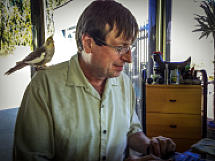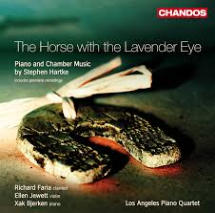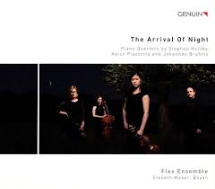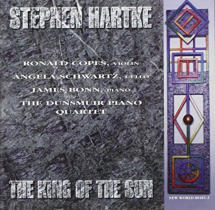
Stephen Hartke
THE KING OF THE SUN (1988)
Tableaux for Violin, Viola, Cello, and Piano
Commissioned for the Los Angeles Piano Quartet by Chamber Music America
Duration: 21 Minutes
1. Personages in the night guided by the phosphorescent tracks of snails
2. Dutch interior
3. Dancer listening to the organ in a Gothic cathedral
Interlude
4. The flames of the sun make the desert flower hysterical
5. Personages and birds rejoicing at the arrival of night
Of the five and one half movements that comprise my piano quartet, The King of the Sun,
it was the second (Dutch interior) that was composed last, and thus, because it was
written with the benefit of hindsight regarding the rest of the work, it is in some ways the
key to the whole. To begin, it bears the word "Phantasmagorically" as its tempo marking
to suggest the constant shifting of musical images that drives the piece. The musical
materials derive from a late medieval canon entitled Le ray au soleyl ("the Sun's ray") that
was jotted down on some empty staves at the foot of a manuscript page otherwise
devoted to a chanson by the Flemish composer Johannes Ciconia (c. 1370-1412), and
hence has been generally misattributed to him even though clearly the work of a less
accomplished musician (though no less delightful for that). The movement title itself, as
is the case with all the other movements, is taken from a painting by Joan Miró. In Miró's
Dutch interior, he based his composition on a picture postcard of a painting by the 17th
century Dutch genre painter Jan Steen, but his treatment is so delightfully willful and
whimsical that the original is barely recognizable. In my Dutch interior, I subject the
canon (which might be considered Dutch in provenance by some) to similar distortion,
most notably rendering it as a violin solo in which the original's contrapuntal character is
negated by the verticals of the violin multiple-stops which must be used to account for all
the notes in the canon's texture. The underpinning of this solo has nothing to do directly
with the violin part, but evokes the spirit of medieval music in its form, an estampie, and
in its isorhythmic structure. The canon also appears in the fourth movement, The flames of
the sun make the desert flower hysterical, now compressed into the bright, violent chords
that open the piece, and then returning at the end in a direct quotation that breaks off
abruptly as soon as the first serious contrapuntal 'error' is heard. The remaining
movements deal with other issues, among them the recurrent 'snail music' heard first at
the very beginning of the work and in several other movements thereafter. But, most
curiously for a piece entitled The King of the Sun, most of the movements take place
indoors or at night, but for the fateful solar encounter of the hapless desert flower. I had
no idea in starting out that this would be the outcome, but I welcomed it, for all its being
somewhat convoluted and even arcane, because, quite simply, it was fun to do. Thus just
as Miró's painting is both whimsical and serious, I have sought to accomplish the same
thing in my music.
Recording:
The Los Angeles Piano Quartet
Chandos 10513
The King of the Sun
The Dunsmuir Piano Quartet
New World Records 80461-2



Flex Ensemble
Genuin 14325










